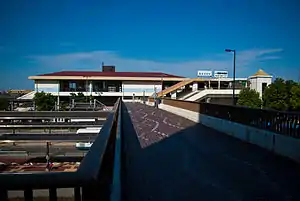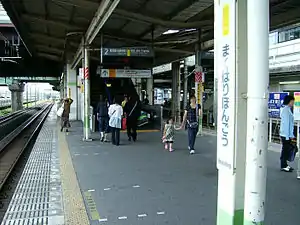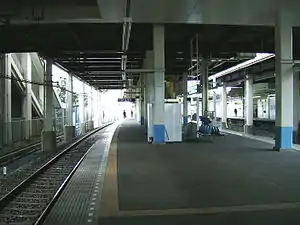Makuharihongō Station
Makuharihongō Station (幕張本郷駅, Makuharihongō-eki) is a railway station in Makuharihongo, Hanamigawa Ward, Chiba City, Chiba Prefecture, Japan, operated by East Japan Railway Company (JR East) and the private railway operator Keisei Electric Railway. The Keisei section of the station is officially named Keisei Makuharihongō Station (京成幕張本郷駅, Keisei Makuharihongō-eki).
Makuharihongō Station Keisei Makuharihongō Station 幕張本郷駅 京成幕張本郷駅 | |
|---|---|
 South entrance in 16 August 2009 | |
| General information | |
| Location | Makuharihongo, Hanamigawa Ward, Chiba City, Chiba Prefecture Japan |
| Operated by | |
| Line(s) | |
| Location | |
 Makuharihongō Station Location within Chiba Prefecture | |
Lines
- JR East - Makuharihongō Station
- Sōbu Main Line (Chūō-Sōbu Line local service)
- Keisei - Keisei Makuharihongō Station
Station layout
Makuharihongō Station consists of two separate sections. The northern section is operated by JR East, and the southern is operated by Keisei Electric Railway. The station building is elevated and located above the platforms, connected to the Teppozuka Overbridge.[1]
JR East
JB34 Makuharihongō Station 幕張本郷駅 | |||||||||||
|---|---|---|---|---|---|---|---|---|---|---|---|
 The JR East platforms | |||||||||||
| General information | |||||||||||
| Location | 1-1-1 Makuharihongo, Hanamigawa Ward, Chiba City, Chiba Prefecture Japan | ||||||||||
| Operated by | |||||||||||
| Line(s) | JB Chūō-Sōbu Line | ||||||||||
| Distance | 29.6 km from Tokyo | ||||||||||
| Platforms | 1 island platform | ||||||||||
| Tracks | 2 | ||||||||||
| Other information | |||||||||||
| Station code | JB34 | ||||||||||
| Website | www | ||||||||||
| History | |||||||||||
| Opened | 1 October 1981 | ||||||||||
| Passengers | |||||||||||
| FY2018 | 29,796 daily[2] | ||||||||||
| Services | |||||||||||
| |||||||||||
The JR East station consists of a single island platform serving two tracks. The station has reserved seat ticket machines.
Platforms
| 1 | JB Chūō-Sōbu Line | for Tsudanuma, Nishi-Funabashi and Akihabara |
| 2 | JB Chūō-Sōbu Line | for Chiba |
Keisei
KS52 Keisei Makuharihongō Station 京成幕張本郷駅 | |||||||||||
|---|---|---|---|---|---|---|---|---|---|---|---|
 | |||||||||||
| General information | |||||||||||
| Location | 1-1-3 Makuharihongo, Hanamigawa Ward, Chiba City, Chiba Prefecture Japan | ||||||||||
| Operated by | |||||||||||
| Line(s) | KS Keisei Chiba Line | ||||||||||
| Distance | 2.1 km from Keisei Tsudanuma | ||||||||||
| Platforms | 1 island platform | ||||||||||
| Tracks | 2 | ||||||||||
| Other information | |||||||||||
| Station code | KS52 | ||||||||||
| History | |||||||||||
| Opened | 7 August 1991 | ||||||||||
| Passengers | |||||||||||
| FY2018 | 8,225 daily[3] | ||||||||||
| Services | |||||||||||
| |||||||||||
The Keisei section of the station consists of a single island platform serving two tracks.
Platforms
| 1 | KS Keisei Chiba Line | for Keisei Tsudanuma and Keisei Ueno SL Shin-Keisei Line for Matsudo |
| 2 | KS Keisei Chiba Line | for Keisei Chiba and Chiharadai |
History
The JR East station opened on October 1, 1981.[4] The Keisei section opened on August 7, 1991.[5]
Station numbering was introduced to all Keisei Line stations on 17 July 2010; Keisei Makuharihongō Station was assigned station number KS52.[6][7]
Passenger statistics
In fiscal 2018, the JR East station was used by an average of 29,796 passengers daily (boarding passengers only).[2]
| Fiscal year | Daily average (JR) |
|---|---|
| 2000 | 27,117[8] |
| 2001 | 26,891[9] |
| 2002 | 26,333[10] |
| 2003 | 25,682[11] |
| 2004 | 25,657[12] |
| 2005 | 25,498[13] |
| 2006 | 25,815[14] |
| 2007 | 26,093[15] |
| 2008 | 26,084[16] |
| 2009 | 25,821[17] |
| 2010 | 25,985[18] |
| 2011 | 25,933[19] |
| 2012 | 25,873[20] |
| 2013 | 26,981[21] |
| 2014 | 27,329[22] |
| 2015 | 27,655[23] |
| 2016 | 28,297[24] |
| 2017 | 29,017[25] |
| 2018 | 29,796[2] |
In fiscal 2018, the Keisei station was used by an average of 8,225 passengers daily (boarding passengers only).[3]
Surrounding area
- JR East Makuhari Depot
- Keiyō Road Makuhari Interchange
- Ōnomatsu stable
- Kaihimmakuhari Station — A 14-minute bus ride from Makuharihongō Station.
- Makuhari Messe — A three-minute walk from the NTT bus stop, which is a nine-minute bus ride from Makuharihongō Station.
Connecting bus services
Keisei Bus and Chiba Seaside Bus operate local bus services from the following Makuharihongō Station bus stops.
| Stop No. | Japanese | Reading | For | Via | Operator |
|---|---|---|---|---|---|
| 0, 1[26] | 幕01 | Makuharihongō 01 | Drivers License Center, Kaihimmakuhari Station, Makuhari Messe, ZOZO Marine Stadium,[27][28] Medical Center | Drivers License Center | Keisei Bus |
| 幕01急行 | Makuharihongō 01 Express | Kaihimmakuhari Station[Note 1] | Keisei Bus | ||
| 幕03 | Makuharihongō 03 | Kaihimmakuhari Station | High-tech Street | Keisei Bus | |
| 幕03急行 | Makuharihongō 03 Express | Techno Garden[Note 2] | High-tech Street | Keisei Bus | |
| 幕04 | Makuharihongō 04 | Wakaba 3-chōme | High-tech Street | Keisei Bus | |
| 4[26] | 津61 | Tsudanuma 61 | Tsudanuma Station | Keisei Bus | |
| 津62 | Tsudanuma 62 | Tsudanuma Station | Keisei Ōkubo Station Minamiguchi (South Entrance) | Keisei Bus | |
| 幕66 | Makuharihongō 66 | Keisei Ōkubo Station Minamiguchi | Keisei Bus | ||
| 5[26] | イオン36 | Aeon Mall 36 | Makuharitoyosuna Station[29] | Aeon Mall Makuhari Shintoshin Aeon Style Entrance | Keisei Bus |
| 6[26] | 幕11 | Makuharihongō 11 | Shin-Narashino Station | Keisei Bus | |
| 幕21 | Makuharihongō 21 | Gakuen Loop Line | Keisei Bus | ||
| 津62 | Tsudanuma 62 | Makuhari-Nishi 5-chōme | Keisei Bus | ||
| 幕22 | Makuharihongō 22 | Hamada Ryokuchi (Hamada Park), Kaihimmakuhari Station | Columbus City | Keisei Bus | |
| 幕23 | Makuharihongō 23 | KUIS | Columbus City | Keisei Bus | |
| 8[30] | JR Makuhari Station | Makuhari 2-chōme | Chiba Seaside Bus |
- runs non-stop to Fujitsu
- runs non-stop to Sharp・SII
See also
References
- 橋梁点検結果 (PDF) (in Japanese). Japan: City of Chiba. Retrieved 23 February 2020.
- 各駅の乗車人員 (2018年度) [Station passenger boarding figures (Fiscal 2018)] (in Japanese). Japan: East Japan Railway Company. Retrieved 1 March 2020.
- 駅別乗降人員(2018年度1日平均) (in Japanese). Japan: Keisei Electric Railway Co., Ltd. Retrieved 1 March 2020.
- Makuharihongō Station information by JR East (in Japanese) Retrieved on 2008-10-27
- "京成電鉄千葉線に新駅" Japan Railfan Magazine October 1991 issue (No. 366), p. 117
- "京成線各駅で「駅ナンバリング」を導入いたします" ["Station numbering" will be introduced to each station on the Keisei Line] (PDF). keisei.co.jp (in Japanese). Archived from the original (PDF) on 28 September 2022. Retrieved 25 February 2023.
- "京成と京急が駅ナンバリングを導入" [Keisei and Keikyu to introduce station numbering]. Tetsudo News (in Japanese). 6 June 2010. Archived from the original on 26 February 2023. Retrieved 26 February 2023.
- 各駅の乗車人員 (2000年度) [Station passenger boarding figures (Fiscal 2000)] (in Japanese). Japan: East Japan Railway Company. Retrieved 16 February 2017.
- 各駅の乗車人員 (2001年度) [Station passenger boarding figures (Fiscal 2001)] (in Japanese). Japan: East Japan Railway Company. Retrieved 16 February 2017.
- 各駅の乗車人員 (2002年度) [Station passenger boarding figures (Fiscal 2002)] (in Japanese). Japan: East Japan Railway Company. Retrieved 16 February 2017.
- 各駅の乗車人員 (2003年度) [Station passenger boarding figures (Fiscal 2003)] (in Japanese). Japan: East Japan Railway Company. Retrieved 16 February 2017.
- 各駅の乗車人員 (2004年度) [Station passenger boarding figures (Fiscal 2004)] (in Japanese). Japan: East Japan Railway Company. Retrieved 16 February 2017.
- 各駅の乗車人員 (2005年度) [Station passenger boarding figures (Fiscal 2005)] (in Japanese). Japan: East Japan Railway Company. Retrieved 16 February 2017.
- 各駅の乗車人員 (2006年度) [Station passenger boarding figures (Fiscal 2006)] (in Japanese). Japan: East Japan Railway Company. Retrieved 16 February 2017.
- 各駅の乗車人員 (2007年度) [Station passenger boarding figures (Fiscal 2007)] (in Japanese). Japan: East Japan Railway Company. Retrieved 16 February 2017.
- 各駅の乗車人員 (2008年度) [Station passenger boarding figures (Fiscal 2008)] (in Japanese). Japan: East Japan Railway Company. Retrieved 16 February 2017.
- 各駅の乗車人員 (2009年度) [Station passenger boarding figures (Fiscal 2009)] (in Japanese). Japan: East Japan Railway Company. Retrieved 16 February 2017.
- 各駅の乗車人員 (2010年度) [Station passenger boarding figures (Fiscal 2010)] (in Japanese). Japan: East Japan Railway Company. Retrieved 16 February 2017.
- 各駅の乗車人員 (2011年度) [Station passenger boarding figures (Fiscal 2011)] (in Japanese). Japan: East Japan Railway Company. Retrieved 16 February 2017.
- 各駅の乗車人員 (2012年度) [Station passenger boarding figures (Fiscal 2012)] (in Japanese). Japan: East Japan Railway Company. Retrieved 16 February 2017.
- 各駅の乗車人員 (2013年度) [Station passenger boarding figures (Fiscal 2013)] (in Japanese). Japan: East Japan Railway Company. Retrieved 16 February 2017.
- 各駅の乗車人員 (2014年度) [Station passenger boarding figures (Fiscal 2014)] (in Japanese). Japan: East Japan Railway Company. Retrieved 16 February 2017.
- 各駅の乗車人員 (2015年度) [Station passenger boarding figures (Fiscal 2015)] (in Japanese). Japan: East Japan Railway Company. Retrieved 15 August 2017.
- 各駅の乗車人員 (2016年度) [Station passenger boarding figures (Fiscal 2016)] (in Japanese). Japan: East Japan Railway Company. Retrieved 15 August 2017.
- 各駅の乗車人員 (2017年度) [Station passenger boarding figures (Fiscal 2017)] (in Japanese). Japan: East Japan Railway Company. Retrieved 13 August 2018.
- "Makuhari Hongo Sta. Bus station map". Japan: Keisei Bus Co., Ltd. Retrieved 9 September 2023.
- 2/16 新都心(営)「QVCマリンフィールド」バス停留所の名称変更について (in Japanese). Japan: Keisei Bus Co., Ltd. Retrieved 16 February 2017.
- 千葉マリン新名称が「ZOZOマリンスタジアム」に決定 (in Japanese). Japan: Chiba Lotte Marines. Retrieved 19 December 2016.
- 幕張本郷駅 時刻表 [Makuharihongō Station Timetable] (in Japanese). Japan: Keisei Bus Co., Ltd. Retrieved 9 September 2023.
- のりば案内 東洋バス・千葉シーサイドバス (in Japanese). Japan: Toyo Bus/Chiba Seaside Bus. Retrieved 27 August 2017.
External links
- JR East station information (in Japanese)
- Keisei station map
- Keisei Bus Makuhari Shintoshin route map (in Japanese)
- Keisei Bus Narashino route map (in Japanese)